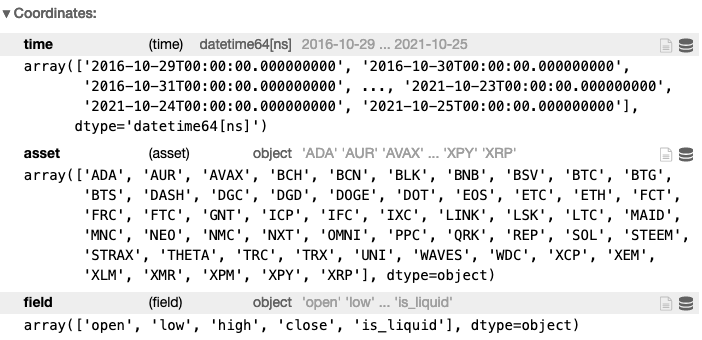Xarray¶
Here we give a short overview of important xarray features.
For a more detailed documentation on Xarray please go to https://xarray.pydata.org/en/stable/ or API-Reference xarray
Overview¶
Consider for example cryptocurrency daily data from the last 5 years:
import xarray as xr
import qnt.data as qndata
data = qndata.cryptodaily_load_data(tail=365*5)
data is an xarray.DataArray, a labelled multi-dimensional array whose key properties are:
values: a numpy.ndarray holding the array’s values;
dims: dimension names for each axis;
coords: a dict-like container of arrays (coordinates) that label each point (e.g., 1-dimensional arrays of numbers, datetime objects or strings);
attrs: a dict to hold arbitrary metadata (attributes).
in our example:
data.values
array([[[ nan, 2.061610e-01, nan, ..., 5.890100e-02,
2.744000e-03, 8.090000e-03],
[ nan, 1.859190e-01, nan, ..., 5.739400e-02,
2.864000e-03, 7.870000e-03],
[ nan, 1.579340e-01, nan, ..., 5.947300e-02,
2.814000e-03, 8.240000e-03],
...],
...,
[[1.000000e+00, nan, 1.000000e+00, ..., 0.000000e+00,
0.000000e+00, 1.000000e+00],
[1.000000e+00, nan, 1.000000e+00, ..., 0.000000e+00,
0.000000e+00, 1.000000e+00],
[1.000000e+00, nan, 1.000000e+00, ..., 0.000000e+00,
0.000000e+00, 1.000000e+00]]])
data.dims
('field', 'time', 'asset')
data.coordinates:

Indexing¶
via integer:
data.isel(time=-1) #read only
data[dict(time=-1)] #also assignment
via label:
data.sel(asset='BTC') #read only
da.loc[dict(asset='BTC')] #also assignment
Example:
data.loc[{'time':'2021-10-19','asset':'BTC','field':'open'}] = 1
data.sel(time='2021-10-19').sel(asset='BTC').sel(field='open')

Functions¶
A few important xarray functions:
new xarray.DataArray with same shapes and dimensions but every value is 0. :
xr.zeros_like(data)
create xarray.DataArray from scratch
data = xr.DataArray(np.random.randn(2, 3), dims=('x', 'y'), coords={'x': [10, 20],'y':[1,2,3]})
data

xr.where(cond, x, y) : When cond is True, return values from x, otherwise returns values from y (x or y can also be scalars)
x = xr.DataArray(0.1 * np.arange(10))
#<xarray.DataArray>
#array([0. , 0.1, 0.2, 0.3, 0.4, 0.5, 0.6, 0.7, 0.8, 0.9])
xr.where(x < 0.5, x, x * 100)
#<xarray.DataArray>
#array([ 0. , 0.1, 0.2, 0.3, 0.4, 50. , 60. , 70. , 80. , 90. ])
xr.where(x < 0.5, 0, 1)
#<xarray.DataArray>
#array([ 0. , 0., 0, 0., 0., 1. , 1. , 1. , 1. , 1. ])